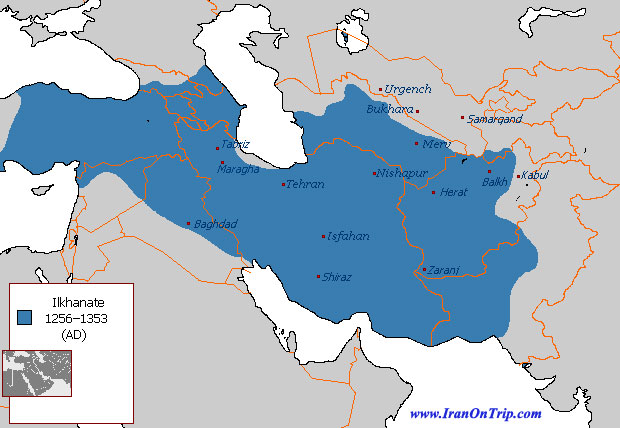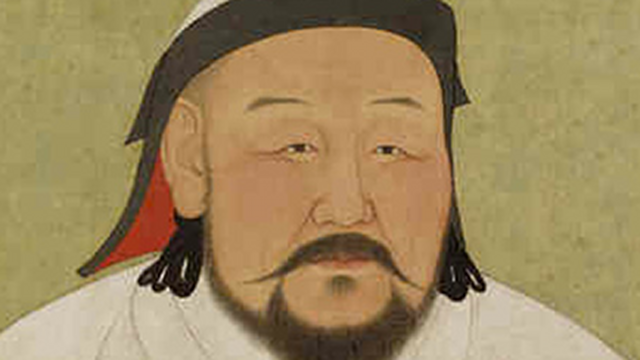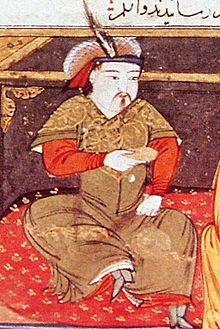Mughal Ilkhanate

The Ilkhanate, also spelled Il-khanate (Persian: ایلخانان, Ilkhanan; Mongolian: Хүлэгийн улс, Hulagu-yn Ulus), was a breakaway state of the Mongol Empire, which was ruled by the Mongol House of Hulagu. It was established in the 13th century and was based primarily in Persia as well as neighboring territories, such as present-day Azerbaijan, and the central and eastern parts of present-day Turkey. The Ilkhanate was based, originally, on Genghis Khan's campaigns in the Khwarazmian Empire in 1219–1224, and was founded by Genghis's grandson, Hulagu Khan. In its fullest extent, the state expanded into territories which today comprise most of Iran, Iraq, Turkmenistan, Armenia, Azerbaijan, Georgia, Turkey, western Afghanistan and southwestern Pakistan. The Ilkhanate initially embraced many religions, but was particularly sympathetic to Buddhism and Christianity. Later Ilkhanate rulers, beginning with Ghazan in 1295, embraced Islam.
Definition

Portrait of Kublai Khan during the Yuan era
According to the historian Rashid-al-Din Hamadani, Kublai granted Hulagu (Hulegu) the title of Ilkhan after his defeat of Ariq Böke. The term il-Khan means "subordinate khan" and refers to their initial deference to Möngke Khan and his successor Great Khans of the entire empire. The title "Ilkhan", borne by the descendants of Hulagu and later another Borjigin princes in Persia, does not materialize in the sources until after 1260.
Early Mongol rule in Persia
When Muhammad II of Khwarezm executed the merchants dispatched by the Mongols, Genghis Khan declared war on Khwārazm-Shāh dynasty in 1219. The Mongols overran the whole empire, occupying all major cities and population centers between 1219 to 1221. Persian Iraq was ravaged by the Mongol detachment under Jebe and Subedei, and they left the area in ruin. Transoxiana also came under Mongol control after the invasion. The undivided area west of the Transoxiana was the inheritance of Genghis Khan's Borjigin family. Thus, the families of the latter's four sons appointed their officials under the Great Khan's governors, Chin-Temür, Nussal and Korguz, in that region.
Muhammad's son Jalal ad-Din Mingburnu returned to Iran in c. 1224 after his exile in India. The rival Turkic states that were all that remained of his father's empire quickly declared their allegiance to him. He repulsed the first Mongol attempt to take Central Persia. However, Jalal ad-Din was overwhelmed and crushed by Chormaqan's army sent by the Great Khan Ögedei in 1231. During the Mongol expedition, Azerbaijan and the southern Persian dynasties in Fars and Kerman voluntarily submitted to the Mongols and agreed to pay tribute. To the west, Hamadan and the rest of Persia was secured by Chormaqan. The Mongols turned their attention to Armenia and Georgia in 1234 or 1236. They completed the conquest of the Kingdom of Georgia in 1238; however, the Mongol Empire began to attack the western parts of Greater Armenia which was under the Seljuks in the next year.
In 1236 Ögedei was commanded to raise up Khorassan and proceeded to populate Herat. The Mongol military governors mostly made camp in the Mughan plain in what is now Azerbaijan. Realizing the danger posed by the Mongols, the rulers of Mosul and Cilician Armenia submitted to the Great Khan. Chormaqan divided the Transcaucasia region into three districts based on the Mongols' military hierarchy. In Georgia, the population were temporarily divided into eight tumens. By 1237 the Mongol Empire had subjugated most of Persia, excluding Abbasid Iraq and Ismaili strongholds, and all of Afghanistan and Kashmir.
After the battle of Köse Dağ in 1243, the Mongols under Baiju occupied Anatolia, while the Seljuk Sultanate of Rûm and the Empire of Trebizond became vassals of the Mongols.
Güyük Khan abolished decrees issued by the Mongol princes that had ordered the raising of revenue from districts in Persia as well as offering tax exemptions to others in c. 1244.
In accordance with the governor Arghun the Elder's (Arghun agha) complaint, Möngke Khan prohibited ortog-merchants and nobles to abuse relay stations, yam (route), and civilians in 1251. He ordered a new census and decreed that each man in the Mongol ruled-Middle East must pay in proportion to his property. Persia was divided between four districts under Arghun. Möngke Khan granted the Kartids authority over Herat, Jam, Bushanj, Ghor, Khaysar, Firuz-Kuh, Gharjistan, Farah, Sistan, Kabul, Tirah, and Afghanistan.
First Ilkhan

Painting of Hulagu Khan by Rashid-al-Din Hamadani early 14th century
The actual founder of the Ilkhanate dynasty was Hulagu Khan, grandson of Genghis Khan and brother of both Möngke Khan and Kublai Khan. Möngke dispatched him to establish a firm Toluid control over the Middle East, and ordered him return to Mongolia when his task was accomplished. Taking over from Baiju in 1255 or 1256, he had been charged with subduing the Muslim kingdoms to the west "as far as the borders of Egypt." This occupation led the Turkmens to move west into Anatolia to escape from the Mongolian tribes. He established his dynasty over the southwestern part of the Mongol Empire that stretched from Transoxiana to Syria. He destroyed the Ismaili Nizari Hashshashins and the Abbasid Caliphate in 1256 and 1258 respectively. After that he advanced as far as Gaza, briefly conquering Ayyubid Syria.
Möngke's death forced Hulagu to return from the Persian heartland for the preparation of Khuriltai (selection of a new leader). He left a small force behind to continue the Mongol advance, but it was halted in Palestine in 1260 by a major defeat at the battle of Ain Jalut at the hands of the Mamluks of Egypt. Due to geo-political and religious issues and deaths of three Jochid princes in Hulagu's service, Berke declared open war on Hulagu in 1262 and possibly called his troops back in Iran. According to Mamluk historians, Hulagu might have massacred Berke's troops and refused to share his war booty with Berke.
Hulagu's descendants ruled Persia for the next eighty years, tolerating multiple religions including Shamanism, Buddhism, and Christianity, ultimately adopting Islam as a state religion in 1295. However, despite this conversion, the Ilkhans remained opposed to the Mamluks (who had defeated both Mongol invaders and Crusaders). The Ilkhans launched several invasions of Syria, but were never able to gain and keep significant ground against the Mamluks, eventually being forced to give up their plans to conquer Syria, along with their stranglehold over their vassals the Sultanate of Rum and the Armenian kingdom in Cilicia. This was in large part due to civil war in the Mongol Empire, and the hostility of the khanates to the north and east. The Chagatai Khanate in Moghulistan and the Golden Horde threatened the Ilkhanate in the Caucasus and Transoxiana, preventing expansion westward. Even under Hulagu's reign, the Ilkhanate was engaged in open warfare in the Caucasus with the Mongols in the Russian steppes. On the other hand, the China-based Yuan Dynasty was an ally of the Ikhanate and also held nominal suzerainty over the latter for many decades. Hulagu took with him many Chinese scholars, astronomers, and the famous Persian astronomer Nasir al-Din al-Tusi learned about the mode of the Chinese calculating tables from the scholars brought to Persia by the Mongols.The observatory was built on a hill of Maragheh.
Conversion to Islam
In the period after Hulagu, the Ilkhans increasingly adopted Tibetan Buddhism. Christian powers were encouraged by what appeared to be a favoring of Nestorian Christianity by the Ilkhanate's rulers but this probably went no deeper than the Mongols' traditional even-handedness towards competing religions. Thus the Ilkhans were markedly out of step with the Muslim majority they ruled. Ghazan, shortly before he overthrew Baydu, converted to Islam and his official favoring of Islam as a state religion coincided with a marked attempt to bring the regime closer to the non-Mongol majority of the regions they ruled. Christian and Jewish subjects lost their equal status with Muslims and again had to pay the poll tax. Buddhists had the starker choice of conversion or expulsion.
In foreign relations, the Ilkhanate's conversion to Islam had little to no effect on the regime's hostility towards the other Muslim states and Ghazan continued to fight the Mamluks for control of Syria. But the Battle of Wadi al-Khazandar, which was the Mongols' only major victory over the Mamluks, ended his control over Syria, though this lasted but a few months. For the most part, Ghazan's policies continued under his brother Öljeitü despite suggestions that he might begin to favor the Shi'a brand of Islam after he came under the influence of Shi'a theologians Al-Hilli and Maitham Al Bahrani. Öljeitü succeeded in conquering Gilan on the Caspian coast and his magnificent tomb in Soltaniyeh remains the best known monument of Ilkhanid rule in Persia.
Disintegration
After Abu Sa'id's death in 1335, the Ilkhanate began to disintegrate rapidly, and split up into several rival successor states, most prominently the Jalayirids. Hasar's descendant Togha Temür, who was the last of the obscure Ilkhan pretenders, was assassinated by Sarbadars in 1353. Timur later carved a state from the Jalayirids, ostensibly to restore the old khanate. The historian Rashid-al-Din Hamadani wrote a universal history for the khans around 1315 which provides much material for their history.
Legacy
The emergence of the Ilkhanate had an important historical impact in the Middle Eastern region. The establishment of the unified Mongol Empire had significantly eased trade and commerce across Asia. The communications between the Ilkhanate and the Yuan Dynasty headquartered in China encouraged this development.
The Ilkhanate also helped to pave the way for the later Persian Safavid dynastic state, and ultimately the modern country of Iran. Hulagu's conquests had also opened Iran to Chinese influence from the east. This, combined with patronage from his successors, would develop Iran's distinctive excellence in architecture. Under the Ilkhans, Iranian historians also moved from writing in Arabic, to writing in their native Persian tongue.
The rudiments of double-entry accounting were practiced in the Ilkhanate; merdiban was then adopted by the Ottoman Empire. These developments were independent from the accounting practices used in Europe. This accounting system was adopted primarily as the result of socio-economic necessities created by the agricultural and fiscal reforms of Ghazan Khan in 1295-1304.
Ilkhans
House of Hulagu (1256-1335; Ilkhanate Mongol kings)
• Hulagu Khan (1256–1265)
• Abaqa Khan (1265–1282)
• Ahmad Tegüder (1282–1284)
• Arghun (1284–1291)
• Gaykhatu (1291–1295)
• Baydu (1295)
• Mahmud Ghazan (1295–1304)
• Muhammad Khodabandeh (Oljeitu) (1304–1316)
• Abu Sa'id Bahadur (1316–1335)
After the Ilkhanate, the regional states established during the disintegration of the Ilkhanate raised their own candidates as claimants.
House of Ariq Boke
• Arpa Ke'ün (1335–1336)
House of Hulagu (1336-1357)
• Musa (1336–1337) (puppet of 'Ali Padshah of Baghdad)
• Muhammad (1336–1338) (Jalayirid puppet)
• Sati Beg (1338–1339) (Chobanid puppet)
• Sulayman (1339–1343) (Chobanid puppet, recognized by the Sarbadars 1341–1343)
• Jahan Temür (1339–1340) (Jalayirid puppet)
• Anushirwan (1343–1356) (Chobanid puppet)
• Ghazan II (1356–1357) (known only from coinage)
.....
.....
.....

.jpg)



























